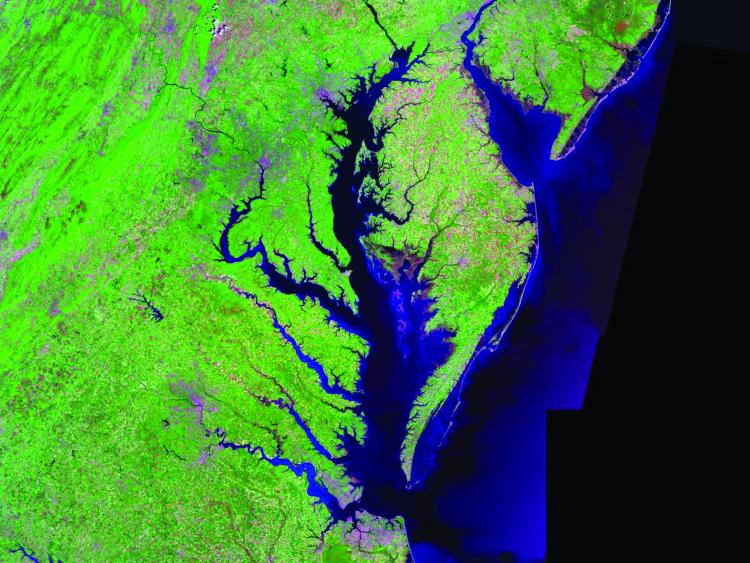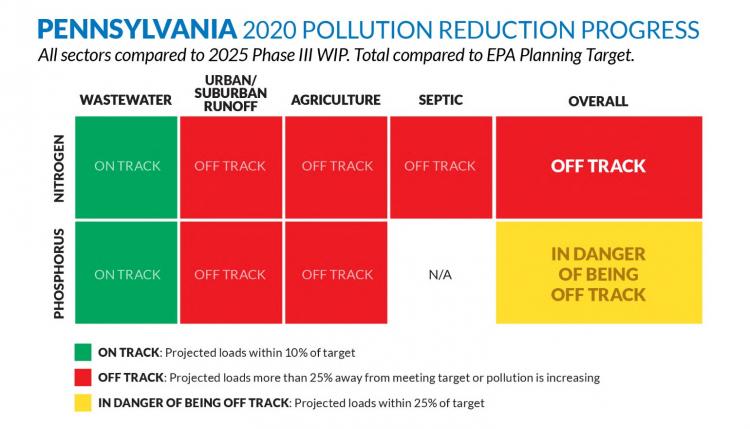CBF Finds Success of Chesapeake Clean Water Blueprint in Jeopardy
With less than four years to go to meet the 2025 implementation deadline of the Chesapeake Clean Water Blueprint, a new Chesapeake Bay Foundation (CBF) assessment of the collective progress by the three primary Chesapeake Bay states found that without significant acceleration the Blueprint will be yet another failed effort to restore this national treasure.

“For more than 35 years, the science has been clear about what must be done to restore the Bay. During that time, there have been multiple restoration agreements that made promises and failed to deliver,” said CBF Vice President for Environmental Protection and Restoration Alison Prost. “Today, it is not too late to finish implementing the Blueprint, but time is running out. Plans on paper are a good start, but implementation on the ground is essential. Without strong leadership from the states, and EPA holding the jurisdictions accountable, the Blueprint will be yet another failure.”
The Chesapeake Clean Water Blueprint is a historic federal/state plan established in 2010 to restore water quality in the region’s rivers, streams, and Chesapeake Bay. It includes pollution limits allocated to each jurisdiction, specific plans to meet those limits with reasonable assurance of success, two-year milestones for accountability, and a commitment from EPA that there would be consequences for failure. The goal is to have programs and practices in place by 2025 that will result in a restored Bay.
From 2009 to 2020, watershed states implemented practices that will reduce the amount of nitrogen reaching the Bay by an estimated 44 percent, leaving more than half the work to be accomplished in just four years. And the primary Bay states—Pennsylvania, Maryland, and Virginia—are responsible for approximately 90 percent of the pollution damaging the Chesapeake Bay.
Overall, Maryland and Virginia are mostly on track to meet their pollution-reduction commitments. But progress to date is largely due to wastewater treatment upgrades, which while important, are not enough to finish the job. To do so, the states need a major acceleration of efforts to address agricultural pollution and a concerning rise in pollution from urban and suburban development.
Historically, Pennsylvania has lagged significantly behind in meeting its commitments for achieving its Clean Water Blueprint. This deficit became more apparent when the Commonwealth submitted its first Phase III Watershed Implementation Plan (WIP) that would meet just 75 percent of its nitrogen reduction commitment and was underfunded by more than $300 million annually.
Pennsylvania recently submitted a revised plan. While CBF is still reviewing the revised plan, our assessment of Pennsylvania’s progress to date finds the Commonwealth far behind where it needs to be. It has an enormous amount of work to catch up that no plan alone will change. Without the commitment of the Governor and General Assembly to provide sufficient funding, there is no reasonable assurance that the needed practices will be put on the ground.
There are more than 25,000 miles of Pennsylvania waters harmed by pollution, and more than 90 percent of the Commonwealth’s remaining pollution reductions must come from agriculture. While farmers are adopting conservation practices, a massive influx of technical and financial assistance is required for implementation at the scale and pace necessary.
More than a year ago, CBF, its partners, and the Attorneys General from Delaware, Maryland, the District of Columbia, and Virginia, filed suit against EPA for its failure to hold Pennsylvania accountable for submitting a Phase III Watershed Implementation Plan that failed to achieve the needed pollution reductions and was underfunded by more than $300 million annually. Without holding the Commonwealth accountable, Bay restoration efforts are certain to fail. Further, despite statements to the contrary, EPA Administrator Regan has yet to appoint a permanent Chesapeake Bay Program leader or Bay special liaison to the Administration.
“To date, EPA Administrator Regan, who now chairs the Chesapeake Executive Council, has failed to take meaningful action. EPA must hold all jurisdictions accountable.” Prost said. “The Biden Administration has the power to make saving this national treasure an environmental success story. If we solve the pollution problems facing the Chesapeake Bay, there is hope for waterways around the country and a path to address the existential challenges of climate change.”
Many of the same pollution-reduction strategies used to the clean up the Bay also mitigate climate change. But restoration efforts still face major challenges from climate change and the impact of growth. Both create additional pollution to local waterways and the Bay.
Climate change is affecting the Chesapeake Bay and its rivers and streams—adding more stress to a system still out of balance. We are seeing increased and intensified storms and water and air temperatures increasing. Without additional action these will likely increase the Bay’s low-oxygen dead zone.
Between 2014 and 2018, the Chesapeake Bay watershed had a net loss of 270,000 acres of forest—an area nearly three times the size of Washington, D.C., Richmond, Annapolis, and Harrisburg combined. In addition, the watershed is adding nearly 25,000 acres per year of new urban development. These are troubling figures for the future. Forests and other open lands provide wildlife habitat, moderate heat, supply fresh water for drinking, trap carbon, and are crucial for filtering out pollution before it reaches rivers, streams, and the Bay. But none of the states are accounting for or adequately offsetting the effects of this loss. Nor do state regulations adequately account for the additional polluted runoff generated by new roads, lawns, buildings, and other hard surfaces.
“There is a glimmer of hope, however. To the credit of the many agency workers, farmers, and local leaders, work in Pennsylvania, while woefully behind, is accelerating. The Commonwealth led the watershed in reducing nitrogen pollution last year, and proposed legislation there would create a new program and provide funding to assist farmers in reducing pollution. Pennsylvania should also follow Virginia’s lead and invest a significant portion of the federal stimulus dollars now in its rainy-day fund to invest in agricultural conservation practices,” Prost added. “The U.S. Department of Agriculture should also step up and increase conservation funding in the region.”
Despite leading the watershed states with 4 million pounds of nitrogen-pollution reduction in 2020, Pennsylvania is not on track to achieve its 2025 pollution-reduction requirements. The Commonwealth is also significantly behind in implementing the practices necessary to close the gap.
On the positive side, farms across Pennsylvania are shifting toward production systems that improve the health of their soils to reduce erosion, nutrient and pesticide loss, and polluted runoff to local streams draining to the Chesapeake Bay. The Commonwealth is on track to meet its milestone targets for the acres of farmland planted in traditional cover crops (crops that are grown off-season to keep soil and nutrients on the land) and using high residue tillage (a conservation practice that leaves more of the soil surface covered with the leaves and stems of cover crops when they are cut down).
 However, Pennsylvania is far off-track meeting targets for practices such as rotational grazing (rotating livestock frequently between pastures to allow fields time to regenerate) and the implementation of soil and water conservation and nutrient management plans.
However, Pennsylvania is far off-track meeting targets for practices such as rotational grazing (rotating livestock frequently between pastures to allow fields time to regenerate) and the implementation of soil and water conservation and nutrient management plans.
In addition, Pennsylvania is far behind in planting forest buffers. Streamside forested buffers, with native trees and shrubs planted along waterways, are one of the most cost-effective practices for reducing nitrogen, phosphorus, and sediment pollution in both rural and urban landscapes. Pennsylvania established just over a quarter of the buffers its two-year milestone commitment calls for by 2021.
Pennsylvania is on pace to meet its 2025 Blueprint targets for wastewater ahead of schedule, largely by installing better technology at treatment plants, enhancing the efficiency of existing treatment plant technologies, or purchasing credits that reduce their contribution to nitrogen and phosphorus pollution. Combined sewer overflows are a challenge for many communities, particularly older cities and boroughs; however, they represent less than 2 percent of Pennsylvania’s wastewater nitrogen loads to the Bay.
Recent analysis indicated that each year, Pennsylvania loses over 18,000 acres of valuable forests, fields, and farmland to development, including new residential areas and massive commercial warehouse and distribution facilities. Managing growth and land use remains especially challenging in Pennsylvania because decision-making power rests with the more than 1,100 municipal governments in its portion of the Bay watershed. However, rising pollution from urban and suburban areas—made worse by extreme rainfall linked to climate change—makes it imperative for the Commonwealth to addresses these challenges.
Pennsylvania is relying largely on Countywide Action Plans to achieve its pollution-reduction commitments. Local citizens, businesses, governments, and non-profit organizations have spent long hours determining how best to reduce pollution in their communities. CBF supports this process, but notes that a lack of technical and financial assistance is thwarting progress.
“Any plan is only as effective as the financial, technical, and oversight support made at the state and federal levels to implement it,” said Harry Campbell, CBF Science Policy and Advocacy Director in Pennsylvania. “State and federal leaders need to follow-through on pending legislation that supports the many boots on the ground, landowners, and communities working hard every day to protect and restore local rivers and streams. They want to do more.”
“Legislation before the Pennsylvania General Assembly proposes that $250 million of the $7 billion in American Rescue Plan money the Commonwealth received go into a Clean Streams Fund,” Campbell added. “Half of the new fund would support the Agricultural Conservation Assistance Program (ACAP). The ACAP is a statewide agriculture cost-share program and an opportunity to fund local farm projects through county conservation districts.”




